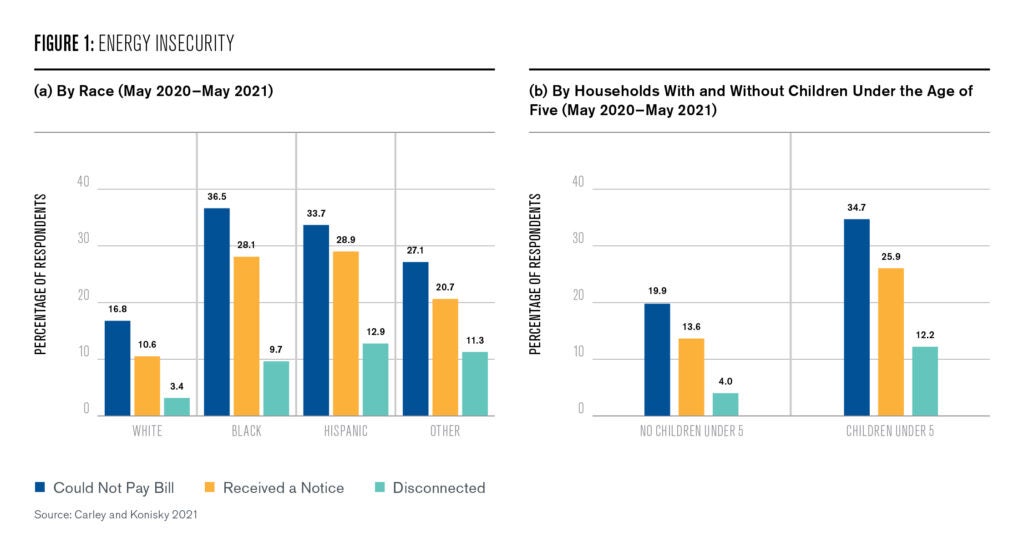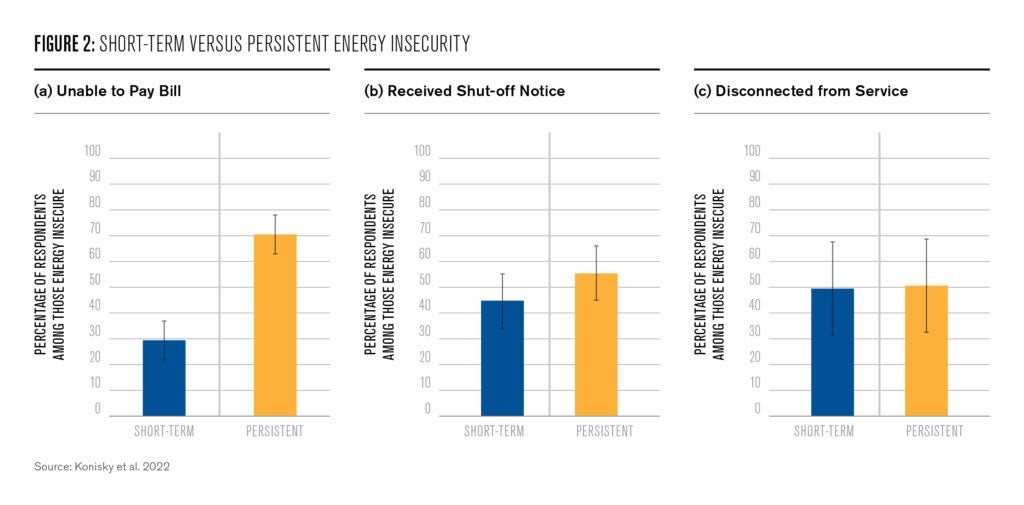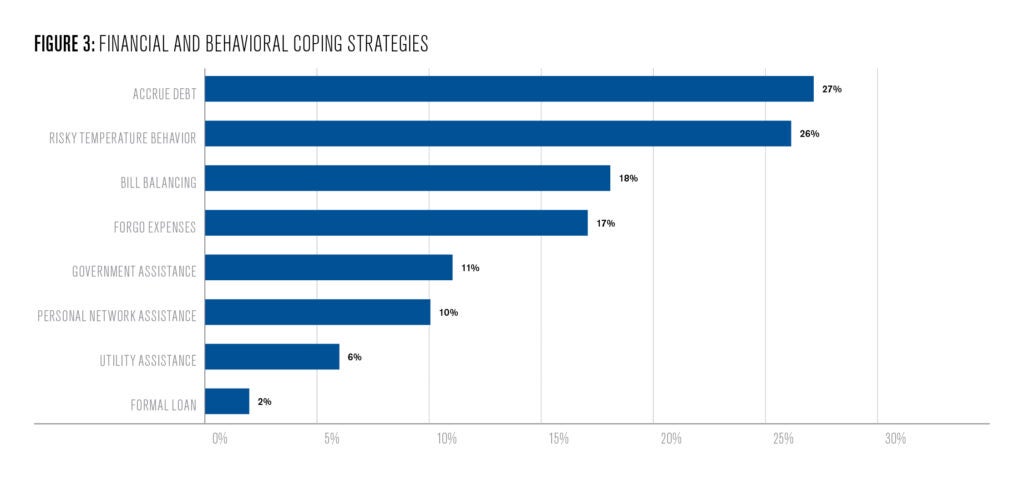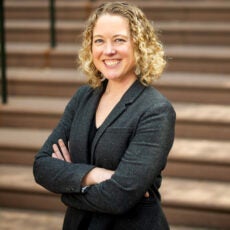Energy Insecurity During the Time of COVID

Millions of Americans struggle to pay their energy bills and avoid being disconnected from their energy services. This digest evaluates the incidence and implications of such for low-income families during the first year of the COVID-19 pandemic.
At A Glance
Key Challenge
Households routinely struggle to pay their bills and avoid disconnection. Half of all households that are disconnected from their energy services are likely to be disconnected again in the near future.
Policy Insight
Governments must offer both short-term bill assistance and debt relief as well as longer-term, preventative, and resilience-building assistance.
When the weather turns from hot to cold, or vice versa, millions of Americans reach for their thermostats to turn up the heat or air conditioning. They pay their utility companies to deliver this service and live in thermal comfort while they resume their daily tasks. Yet, millions of other Americans cannot take this same action due to an inability to pay for these services (Cong et al. 2022).
These energy insecure individuals, or full households, face difficult and in some cases life threatening tradeoffs: live in thermal discomfort or sacrifice other essential needs that allow them enough money to pay their energy bills. When they cannot cover their bills, they face the threat of utility disconnection, whereby their electricity or gas is cut off.
Living in the state of energy insecurity—and thus in potentially dangerous temperature conditions or under significant stress and duress—can affect one’s mental and physical health (Liddell and Morris 2020; Hernández and Siegel 2019; Zhang et al. 2021).
Energy insecurity may perpetuate long-term poverty (Bohr and McCreery, 2020) and may lead to developmental delays for children (Cook et al. 2008), who are more likely to experience health complications and hospitalization due to temperature conditions and from consuming fewer calories when households make tradeoffs between paying for energy and food (Nord and Kantor 2006; Bhattacharya et al. 2002). The loss of utility service can also lead to homelessness (Clark et al. 2021).
The U.S. government tracks energy insecurity through their Residential Energy Consumption (RECS) survey, which the U.S. Energy Information Administration administers every five years. In 2015, the RECS survey data revealed that one out of every three Americans struggles to pay their energy bills and keeps their home at inadequate temperatures, and one in four households must forgo paying for necessities such as food in order to pay their energy bills (U.S. EIA 2015).
Yet, since 2015, energy prices have increased in many places across the country (McClain 2021) and a significant number of conditions and events have affected both the short-term and long-term outlook for energy prices, including but not limited to Texas’ winter storm Uri and California’s repeated extreme weather events that affected power supplies (Kemabonta 2021; Su et al. 2020); the announced utility retirements of some coal power facilities that retain stranded assets that still must be recovered via electricity rates; and the Russian invasion of Ukraine. In addition, since 2015, a major and prolonged event has also fundamentally changed energy consumption patterns, as well as public health, employment patterns, and just about every other aspect of our lives: the COVID-19 pandemic.
At the onset of the pandemic, as government officials declared stay-at-home orders, it became quickly apparent that energy consumption would move from the workplace into residential homes (Cicala 2020; Lou et al. 2021). In order to track these developments, and how they would affect energy insecurity in months to come, my research collaborators and I administered an online survey to a nationally representative panel of low-income households—defined as within 200% of the federal poverty line—every several months (for detail on the survey design, see Konisky et al. 2022).
We followed approximately 2,000 families over the first year of the COVID-19 pandemic—including interviews with those who experienced disconnections—and learned from them about their incidence and lived experiences with energy insecurity, lessons that are both instructive for understanding energy insecurity in general as well as under the special circumstances of a global pandemic with emergency policy protections. Here, I summarize some of the main findings of this work and discuss several policy implications.
Energy Insecurity Is Pervasive and Disparate
Over the first year of the COVID-19 pandemic, from approximately May 2020 through May 2021, 24% of all low-income households struggled to pay their bills and 8% were completely disconnected from their service providers on at least one occasion (Carley and Konisky 2021). This rate of disconnection was this high despite that over half of the U.S. states had emergency disconnection moratoria in place for at least a couple of months, which protected consumers from being shut-off during that time1. To put these numbers in context, using estimates from the American Community Survey of low-income households across the U.S., this amounts to about 23.5 million people who struggled with energy bills and 7.5 million who were disconnected from electricity or gas service.
Energy insecurity is not experienced evenly across socio-demographic groups, a finding that has been raised previously in the literature as well (see, e.g., Bednar and Reames, 2020; Brown et al. 2020). Through statistical analysis, we also found that certain groups are significantly more likely to struggle to pay their energy bills, such as the lowest income households, and also experience higher rates of disconnection, including households of color, those with children under the age of five, those with members who rely on electronic medical devices, and those who report having deficient or inefficient housing conditions (Memmott et al. 2021).
Figure 1 shows that some of these disparities are quite large, such as the case with households of color (Figure 1a), where we can observe that Black households are disconnected three times more often than white households, and Hispanic households are four times more often. Figure 1b shows that these disparities are also pronounced for households with young children, which are three times more likely to be disconnected than households without young children.

Energy Insecurity Is Often Reoccurring
When households experience energy insecurity—as measured by a reported difficulty in paying one’s energy bills, receiving a notice for disconnection, and being disconnected, respectively—they are more likely to experience it on multiple occasions. In our analysis (Konisky et al. 2022), we distinguish between those households who face these conditions only once over the course of the first year of the pandemic versus those who experience it two or more times. The differences are striking.
Of those who struggled to pay a bill, 30% experienced it only once, whereas 70% experienced it two or more times, as shown in Figure 2. While the percentages are closer for those who were disconnected—49% once and 50% more than once—it is nonetheless noteworthy that such a high percentage of low-income households experienced this potentially traumatic situation on multiple occasions. Those households who are the most likely to experience energy insecurity on a reoccurring basis are also more likely to be households of color, those with young children, those with members who rely on electronic medical devices, and those who have deficient housing conditions (e.g., holes in their walls) (Konisky et al. 2022).

Our interviews with households who have been disconnected reveal just how difficult it is to break this cycle of energy insecurity once it starts. To be disconnected, one typically is behind on paying their energy bills, which means that they are already facing financial distress. This distress is often constant, because a household’s income is often persistently low relative to their required expenses, a challenge made only worse during the winter months when bills tend to rise.
Once a household is disconnected, they will not only have to pay back the debt that they owe, but they may also have to pay disconnection or reconnection fees, or both. In some places, these fees are small or nonexistent, but in other places across the country they can be more than a hundred dollars. If one’s power is off long enough, they will lose all of the food in their refrigerator, putting them even more behind financially; they may also seek alternative shelter. Children may also be removed from the home if the house is deemed inhospitable for them. All of these events and infractions make it increasingly difficult for a household to simply move past the original incident. Instead, energy insecurity becomes a reoccurring and persistent problem.
Coping Strategies Are Risky
When a household struggles to afford their energy bills, they tend to use financial and behavioral strategies to get by. Over the first year of the pandemic, approximately 55% of all low-income households used at least one such strategy and the majority of these households used several at once (Carley et al. 2022). Yet, the most common of these are also the most risky to one’s personal and financial health, as seen in Figure 3.
For example, 27% of all low-income households carried debt on their utility bills; 26% sought warmth through a risky temperature strategy such as burning trash in their home or opening an oven for space heat; and 17% forwent expenses on other essential items such as food in order to pay their bills. Less common strategies included seeking payment assistance from the government (11%); borrowing money from friends of family (10%), or calling the utility company for help (6%). The last statistic is particularly noteworthy, since many utilities can offer at least some type of billing assistance or a payment plan, yet households are more inclined to carry debt or use dangerous warming strategies than engage with the utilities about payment options.

Those households who employ these strategies most often are those who have experienced previous incidence of energy insecurity including being disconnected, who have deficient or inefficient housing conditions, or who have more vulnerable populations residing within the home (e.g., young children and those who rely on electronic medical devices) (Carley et al. 2022). For example, we find that those who have young children in the home are significantly more likely to forgo expenses on food and medical care in order to pay the utility bill, and are also significantly more likely to take on utility debt.
Protections Must Be Binding and Simple
In the first few months of the pandemic, 34 states and Washington D.C. enacted temporary moratoria on utility disconnections (Baker et al. 2021). The majority of these moratoria expired several months later, although California’s lasted over a year. In most states, these moratoria differed markedly from ongoing seasonal disconnection protections that states regulate such as weather- and date-based protections, or special qualifications for vulnerable populations.
Ongoing and seasonal protections tend to be riddled with stipulations and specific consumer requirements for qualifications. If the consumer cannot abide by the requirements, such as procuring a doctor’s note before their notice of disconnection is received, then they are fully vulnerable to disconnection.
The pandemic moratoria was often presented as a mandate that no one could be disconnected—with some exceptions such as the state of Alaska, which required signed documentation of hardship and a previous attempt to work with the utility to set up a payment plan (Baker et al. 2021).
In our analysis (Memmott et al. 2023), we evaluated whether these temporary moratoria implemented during the pandemic were successful at helping households avoid disconnection and avoid the “heat or eat” dilemma. We found that the disconnection moratoria were effective on both accounts. The clarity of the stipulations sent a direct message to utilities that it was a time of crisis and they were not to disconnect consumers as they managed this crisis.
While this result may not be surprising—bans on disconnections helped prevent disconnections—there are important insights that one can glean from this study. Overly complicated stipulations can lead to confusion and increased administrative burdens on behalf of the customer. More direct and concrete protections leave little room for interpretation for either the consumer or the utility. In addition, with a changing climate and more frequent extreme weather events, regulators may need to mobilize such protections more often.
Our research findings about those households who are most likely to suffer from persistent energy insecurity and those who have to resort to the riskiest coping strategies, respectively, also lend important insights for disconnection protections. In both analyses, we found that households with particularly vulnerable members—specifically those with young children and those with medically compromised individuals—are more likely to be repeatedly disconnected and to resort to dangerous coping strategies.
Disconnection protections can be tailored toward these households year-round to help protect them. Yet, at present only four states offer disconnection protections for households with young children. All but six states offer medical protections, but a careful inspection of their legal code suggests opportunities for enhanced clarity and reduced administrative burden for customers who seek such protections.
Developing Solutions
This collective body of scholarship, as well as the broader literature in which it is situated, lends insights on ways in which policies can better protect energy insecure populations and help prevent others from entering the state of insecurity. In addition to tighter and more clear disconnection protections, governments and other organizations can seek to expand, target, and reduce administrative burdens associated with both energy bill assistance programs (e.g., the Low-Income Home Energy Assistance Program or utility customer assistance programs) and weatherization programs (e.g., the Weatherization Assistance Program).
Such efforts can include, but are not limited to, increasing annual appropriations for these programs, which has already begun due to the passage of the Inflation Reduction Act and the Bipartisan Infrastructure Law; having administrators work closely with community agencies and leaders to encourage consumer participation (Reames 2016); coordinating efforts with other social assistance programs, including both housing and food assistance; and spreading funds across the full year so that they are available during the colder and hotter months and also in the event of unforeseen crises.
Most of these discussed policies, however, are reactionary: they assist households once they are already struggling to pay their bills or facing the threat of utility disconnection. A challenge for governments, utilities, and consumer advocates is to also codesign preventative and resilience-building efforts that help keep households from ever entering the persistent cycle of energy insecurity.
Weatherization is a form of preventative assistance, for instance, in which a household seals open cracks and adds extra insulation, which can result in an immediate reduction in their energy bills. Other preventative and resilience-building efforts can include expanding access and affordability of energy-efficient appliances and vehicles, residential solar and battery storage, and smart technologies; or longer-term customer assistance programs that ensure that customers have affordable bills on an ongoing basis. All of these suggested efforts require a dedication to upholding equity as a primary policy objective and seeking solutions not just for traditionally disadvantaged and underserved communities but also with them.
As our energy systems change in the transition toward decarbonization, and as climate change continues to evolve and manifest in more extreme weather events and climactic conditions, the need to identify and target energy insecurity will only increase. Targeted efforts will necessitate an understanding of the dimensions of this complex challenge, as well as a policy agenda that seeks both immediate relief and protection for vulnerable populations, as well as preventative and resilience-building measures.
Sanya Carley
Mark Alan Hughes Faculty DirectorSanya Carley is the Faculty Director of the Kleinman Center. She is also Vice Provost for Climate Science, Policy, and Action at Penn and Presidential Distinguished Professor of Energy Policy and City Planning at the Stuart Weitzman School of Design.
Baker, S.H., S. Carley, D.M. Konisky. 2021. “Energy Insecurity and the Urgent Need for Utility Disconnection Protections.” Energy Policy.
Bhattacharya, J., T. DeLeire, S. Haider, J. Currie. “Heat or Eat? 2003. Cold-Weather Shocks and Nutrition in Poor American Families.” American Journal of Public Health 93, 1149–1154.
Bednar, D. J., T.G. Reames. 2020. Recognition of and Response to Energy Poverty in the United States. Nature Energy 5 432–9.
Bohr, J., A.C. McCreery. 2020. “Do Energy Burdens Contribute to Economic Poverty in the United States?” A panel analysis. Social Forces 99, 155–177.
Brown, M.A., A. Soni, M.V. Lapsa, K. Southworth, M. Cox. 2020. “High Energy Burden and Low-Income Energy Affordability: Conclusions from a Literature Review.” Progress in Energy 2.
Carley, S., M. Graff, D. Konisky, T. Memmott. 2022. Behavioral and Financial Coping Strategies Among Energy Insecure Households. Proceedings of the National Academy of Sciences.
Carley, S., D.M. Konisky. 2021. Survey of Household Energy Insecurity in Time of COVID. Wave 4 Report.
Clark, A.Y., N. Blumenfeld, E. Lal, S. Darbari, S. Northwood, A. Wadpey. 2021. “Using K-Means Cluster Analysis and Decision Trees to Highlight Significant Factors Leading to Homelessness.” Mathematics 9(17).
Cicala, S. 2020. “Powering Work from Home.” NBER Working Paper 27937.
Cong, S., D. Nock, Y. L. Qiu, B. Xing. 2022. “Unveiling Hidden Energy Poverty Using the Energy Equity Gap.” Nature Communications 13(1), 1-12.
Cook, John T., et al. 2008. “A Brief Indicator of Household Energy Security: Associations with Food Security, Child Health, and Child Development in U.S. Infants and Toddlers.” Pediatrics 122(4).
Hernández, D., E. Siegel. 2019. “Energy Insecurity and Its Ill Health Effects: A Community Perspective on the Energy–Health Nexus in New York City.” Energy Research & Social Science 47, 78–83.
Kemabonta, T. 2021. “Grid Resilience Analysis and Planning of Electric Power Systems: The Case of the 2021 Texas Electricity Crises Caused by Winter Storm Uri (#TexasFreeze).” The Electricity Journal 34(10).
Konisky, D.M., S. Carley, M. Graff, T. Memmott. 2022. The Persistence of Household Energy Insecurity During the COVID-19 Pandemic. Environmental Research Letters.
Liddell, C., C. Morris. 2010. “Fuel Poverty and Human Health: A Review of Recent Evidence.” Energy Policy 38, 2987–2997.
Lou, J., Y. L. Qiu, A. L. Ku, D. Nock, B. Xing. 2021 “Inequitable and Heterogeneous Impacts on Electricity Consumption from COVID-19 Mitigation Measures.” iScience 24.
McClain, W. 2021. “Trends in Electricity Prices During the Transition Away from Coal.” Bureau of Labor Statistics, May 2021.
Memmott, T., S. Carley, M. Graff, D.M. Konisky. 2021. “Socioeconomic Disparities in Energy Insecurity Among Low-Income Households Before and During the COVID-19 Pandemic.” Nature Energy 6: 186-193.
Memmott, T., S. Carley, M. Graff, D.M. Konisky. 2023. “Utility Disconnection Protections and the Incidence of Energy Insecurity in the United States.” iScience.
Nord, M., L.S. Kantor. 2006. “Seasonal Variation in Food Insecurity Is Associated with Heating and Cooling Costs Among Low-Income Elderly Americans.” Journal of Nutrition 136, 2939–2944.
Reames, T.G., 2016. “A Community-Based Approach to Low-Income Residential Energy Efficiency Participation Barriers.” Local Environ. 21, 1449–1466.
Su, Y., J. Kern, P. Reed, G. Characklis. 2020. “Compound Hydrometeorological Extremes Across Multiple Timescales Drive Volatility in California Electricity Market Prices and Emissions.” Applied Energy 276.
U.S. Energy Information Administration. 2015. “One In Three U.S. Households Face challenges in Paying Energy Bills in 2015.” Residential Energy Consumption Survey.
Zhang, Z., H. Shu, H. Yi, X. Wang. 2021 Household Multidimensional Energy Poverty and Its Impacts on Physical and Mental Health. Energy Policy 156.
- These estimates, however, do not account for those individuals who rely on propane or heating oil and who were disconnected or unable to pay for these services. Note that these services are not typically regulated by the state and thus, even in the case of state-wide disconnection moratoria, customers with such services will not be protected from disconnections. [↩]

